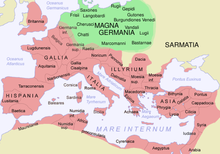Barbaricum
The geographical collective term Barbaricum was coined based on the ancient language. It is sometimes used in historical and archaeological circles for the area bordering the Roman Empire (according to Roman belief, only inhabited by “ barbarians ”) beyond the Limes in northern, central and south-eastern Europe. In late antiquity it was the Latin name for the tribal territories beyond the Rhine and Danube that were not occupied by the Romans (but not for Persia, for example ): Ammianus Marcellinus used it, as did Eutropius . The earliest inscribed evidence seems to come from the early 3rd century.
In research, the terms Germania (which means Germania Magna ) and Barbaricum are sometimes used synonymously, but the terms are not completely congruent in their temporal or spatial meaning. The non- Roman area, known as Barbaricum , has not been exclusively inhabited by Teutons since the beginning of the migration period, although they made up the majority of the population until late antiquity. During the Migration Period, Alans and Huns also advanced into this area, as did Slavic tribes (since the 6th century) who settled the area east of the Albis ( Elbe ) , which was largely abandoned by the Germans .
The diverse cultural, social and economic contacts between the (Germanic) Barbaricum and the empire since the early imperial era should be emphasized . Archaeologically, numerous Roman imports can be proven in the finds in the Barbaricum . The formation of large Germanic tribal associations ( Alemanni and Franks ) from the time of the imperial crisis of the 3rd century was probably influenced by contacts with the Roman world. “Barbarians” could also make a career in the Roman military .
literature
- Hans Jürgen Eggers : The Roman import in free Germania. Atlas Urgesch. 1, Hamburg 1951.
- Jutta Frings (arr.): Rome and the barbarians. Europe at the time of the Great Migration. Hirmer, Munich 2008.
- Guy Halsall: Barbarian Migrations and the Roman West, 376-568 . Cambridge 2007.
- Gustav Adolf Lehmann : Imperium and Barbaricum. New findings and insights into the Roman-Germanic disputes in northwestern Germany - from the Augustan occupation phase to the Germanic procession of Maximinus Thrax (235 AD) . Vienna 2011.
- Ulla Lund Hansen: Roman Empire . In: Reallexikon der Germanischen Altertumskunde . Vol. 25 (2003), pp. 90ff.
- Walter Pohl : The Teutons . 2nd edition Munich 2004.
- Helmuth Schneider (ed.): Hostile neighbors. Rome and the Teutons . Böhlau Verlag, Cologne 2008, ISBN 978-3-412-20219-4 .
- Roland Steinacher : Rome and the barbarians. Peoples in the Alpine and Danube region (300–600). Kohlhammer, Stuttgart 2017, ISBN 978-3-17-025168-7 .
- Herwig Wolfram : The Roman Empire and its Germanic Peoples: A narrative of origin and arrival. Böhlau, Vienna / Cologne / Weimar 2018.
Web links
Remarks
- ↑ Cf. for example Hubert Fehr, Philipp von Rummel: Die Völkerwanderung. Stuttgart 2011, p. 30.
- ↑ See e.g. B. Ammianus 18,2,14: in barbarico
- ↑ Eutropius 7,9: trans Albim fluvium [...], qui in Barbarico longe ultra Rhenum est ( about the Elbe, which is in the barbarian country far beyond the Rhine ).
- ↑ Tadeusz Sarnowski: Barbaricum and a bellum Bosporanum in an inscription from Preslav. In: Zeitschrift für Papyrologie und Epigraphik 87 (1991), pp. 137–144, here p. 143.
- ↑ In Polish archaeological research, for example, the area called Barbaricum extends much further to the east than can be reconciled with the reference to the Teutons, cf. Rosemarie Müller: Reactions to the Germanic-German equation in Eastern Central Europe . In: Heinrich Beck (Ed.): On the history of the equation "Germanic-German" . Berlin 2004, p. 265ff., Here p. 269. On the term see also Ulla Lund Hansen: Römische Kaiserzeit . In: Reallexikon der Germanischen Altertumskunde . Vol. 25 (2003), pp. 90ff., Here p. 90.
- ↑ On the migration of peoples cf. introductory among others Hubert Fehr, Philipp von Rummel: Die Völkerwanderung. Stuttgart 2011; Guy Halsall: Barbarian Migrations and the Roman West, 376-568. Cambridge 2007.
- ↑ See also Hans Jürgen Eggers : The Roman import in free Germania. Atlas Urgesch. 1, Hamburg 1951; Siegmar von Schnurbein : From the influence of Rome on the Teutons. North Rhine-Westphalia. Akad. Wiss. Lectures G 331. Opladen 1995; Siegmar von Schnurbein, M. Erdrich: The project: Roman finds in the Central European Barbaricum, illustrated using the example of Lower Saxony. Report of the Roman-Germanic Commission 73, 1992, pp. 5–27.
- ↑ For general information on these contacts, see Walter Pohl: Die Germanen . 2nd edition Munich 2004, cf. also Guy Halsall: Barbarian Migrations and the Roman West, 376-568 . Cambridge 2007, pp. 138ff.
